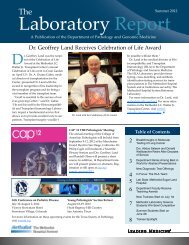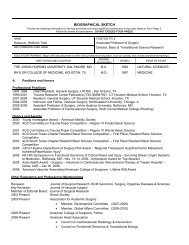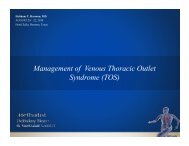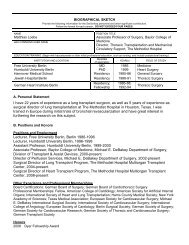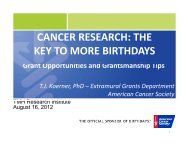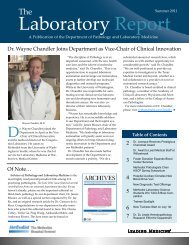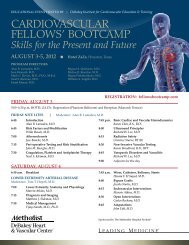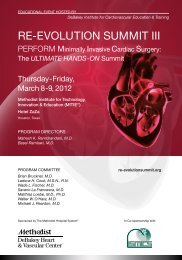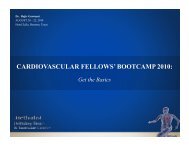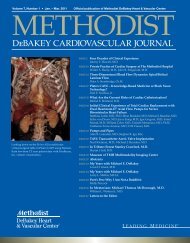The Facts Karla M. Ku - The Methodist Hospital
The Facts Karla M. Ku - The Methodist Hospital
The Facts Karla M. Ku - The Methodist Hospital
Create successful ePaper yourself
Turn your PDF publications into a flip-book with our unique Google optimized e-Paper software.
V E N O U S T H R O M B O S I S T R I A L S AT<br />
T H E M E T H O d I S T H O S P I TA L I N H O U S TO N<br />
J a m e s M u n t z<br />
F r o m M e t h o d i s t D e B a k e y H e a r t C e n t e r, H o u s t o n , Te x a s<br />
IntRoduCtIon<br />
Venous thromboembolism continues to be a significant problem in hospitalized patients. 1 according to Geerts et al.,<br />
“the rationale for thromboprophylaxis is based on the high prevalence of venous thromboembolism among hospitalized<br />
patients, the clinically silent nature of the disease in the majority of patients, and the morbidity, costs and<br />
potential mortality associated with unprevented thrombi.” 2,3 approximately two million americans suffer from deep<br />
vein thrombosis (dVt) each year, 4 but because most of these clots are silent, the true incidence is actually unknown.<br />
In addition to the acute thrombotic event with its inherent morbidity and time missed from work, the late sequelae<br />
from even properly treated thrombi can present as venous stasis and leg ulcers.<br />
thromboembolic disease is responsible for approximately 200,000 deaths annually in the united states alone. 5<br />
the elderly are at highest risk, with a one-year mortality approaching 21%. 6 although excellent drugs are currently<br />
available to prevent and treat dVt, an investigation into new drugs with new targets and designer end points of anticoagulation<br />
seemed clinically relevant and timely.<br />
the following paper will discuss the different antithrombotic/anticoagulant agents that have been used in clinical<br />
trials at the methodist <strong>Hospital</strong> in Houston, texas. several of the trials have been successfully completed and<br />
featured in medical publications such as the New England Journal of Medicine and <strong>The</strong> Lancet.<br />
n e W a n t I t H R o m B o t I C<br />
s t R at e G I e s<br />
According to a review by Hirsh and<br />
Weitz, “anticoagulant strategies to block<br />
thrombogenesis have focused on inhibiting<br />
thrombin, preventing thrombin<br />
generation, or blocking the initiation<br />
of coagulation” (Figure 1). 7 <strong>The</strong> drugs<br />
studied at <strong>The</strong> <strong>Methodist</strong> <strong>Hospital</strong> will<br />
be discussed in chronological order,<br />
with the first new class of anticoagulant<br />
drugs being one of the Factor Xa inhibitors,<br />
pentasaccharide.<br />
f o n d a Pa R I n u X<br />
Fondaparinux is the first of a new class of<br />
antithrombotics: the synthetic inhibitors<br />
of Factor Xa (SIXa). Originally termed<br />
ORG31540/SR90107A, fondaparinux<br />
is a unique and novel pentasaccharide<br />
produced by total chemical synthesis<br />
and designed specifically to bind its<br />
target, the protein antithrombin, with<br />
very high affinity. Fondaparinux (trade<br />
name Arixtra) is obtained exclusively<br />
by chemical synthesis from basic building<br />
blocks synthesized from glucose,<br />
glucosamine and cellobiose. It has guar-<br />
anteed batch-to-batch consistency that<br />
eliminates the risk of contamination by<br />
pathogenic agents. 8<br />
<strong>Methodist</strong> physicians participated in<br />
the drug’s Phase II and Phase III trials,<br />
with ours being the largest enrolling site<br />
worldwide in the Phase II Pentathlon<br />
trial. Phase IIb studies, which included<br />
more than 900 patients undergoing<br />
total hip replacement surgery and 400<br />
undergoing knee replacement surgery,<br />
demonstrated statistically significant<br />
dose-dependent reductions in the risk<br />
of DVT with this agent. 9<br />
We also participated in a multi-center,<br />
double-blinded, dose-ranging Phase II<br />
study to determine optimal dosing in<br />
933 patients undergoing primary total<br />
hip replacement surgery. 10 Figures 2 and<br />
3 outline the efficacy and safety results<br />
from this trial. 11 Following this were<br />
four Phase III trials-randomizing more<br />
than 7,000 patients on five continentswhich<br />
demonstrated that once-daily<br />
fondaparinux in a 2.5 mg subcutaneous<br />
dose reduced the risk of overall<br />
DVT by 50% compared with the established<br />
standard of care (enoxaparin) in<br />
patients undergoing major orthopedic<br />
surgery. 12 <strong>The</strong>se trials provided significant<br />
support of fondaparinux and were<br />
the basis of eventual FDA approval of<br />
the drug in orthopedic populations.<br />
X I m e l a G at R a n<br />
A prodrug of the active site-directed<br />
thrombin inhibitor melagatran, ximelagatran<br />
is absorbed from the small<br />
intestine and was the next drug to be<br />
studied in orthopedic populations at <strong>The</strong><br />
<strong>Methodist</strong> <strong>Hospital</strong>. 13 Ximelagatran<br />
has a plasma half-life of three to four<br />
hours and was administered in a twicedaily<br />
dose. This drug was considered a<br />
savior in the anticoagulation world as it<br />
has no food or drug interactions and,<br />
due to its very predictable response, did<br />
not appear to require any anticoagulant<br />
monitoring.<br />
To evaluate the utility of this drug<br />
in North American orthopedic populations,<br />
we participated in the Platinum<br />
hip and knee trials. <strong>The</strong> Platinum<br />
Hip Trial randomized 1,557 patients<br />
with adequate venography undergoing<br />
total hip replacement to receive oral<br />
II (1) 2006 | JMDHC



